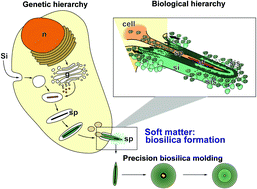Genetic, biological and structural hierarchies during sponge spicule formation: from soft sol–gels to solid 3D silica composite structures†
Abstract
Structural biomaterials are hierarchically organized and biofabricated. Although the structural complexity of most bioskeletons can be traced back from the millimeter-scale to the micrometer- or submicrometer-scale, the biological and/or genetic basis controlling the synthesis of these skeletons and their building blocks remained unknown. There is one distinguished example, the spicules of the siliceous sponges, for which the principle molecules and molecular-biological processes involved in their formation have been elucidated in the last few years. In this review, recent data on the different levels of molecular, biological and structural hierarchies controlling the synthesis of the picturesquely and intricately architectured spicules are summarized. The silicateins and their interacting/maturated proteins comprise the basic enzymatic/proteinous machinery that facilitates the polycondensation of silicate to biosilica. Two isoforms of silicatein, silicatein-α and silicatein-β, the enzyme that catalyzes the polymerization of orthosilicate to polymeric biosilica, have been identified. The remarkable feature of these enzymes is that, besides their enzymatic function, they act as structure-giving proteins that provide the platform for the organization of the silica spicules. Silicatein-α together with silicatein-β forms pentameric units that continue to grow in a linear pattern. The silicatein-interacting protein, silintaphin-1, stabilizes the initially formed silicatein fractals, while silintaphin-2 provides Ca2+ ions required for the appositional growth of the spicules. The biosilica formed during the enzymatically driven sol–gel process that is catalyzed by this multi-protein system is a soft, gel-like inorganic polymer. This soft biosilica undergoes a biologically controlled process of syneresis, resulting in a shrinkage of the silica network. During this reaction the biosilica is transformed into an elastic solid and gains the characteristic spicule morphology. A sizeable amount of protein, mostly silicatein, remains embedded in the biosilica material, thus forming a hybrid bioinorganic (“biosilica”) material. The process of syneresis involves the removal of water by cell-membrane-associated aquaporin channels and is guided by collagen bundles. Four cell types, sclerocytes, archaeocytes, chromocytes and lophocytes, participate in this structure-guiding process. In conclusion, this article attempts to overcome the frontiers in the understanding of the different levels of hierarchies, genetic, biological and structural, and to contribute towards the fabrication of new bioinspired functional materials.


 Please wait while we load your content...
Please wait while we load your content...